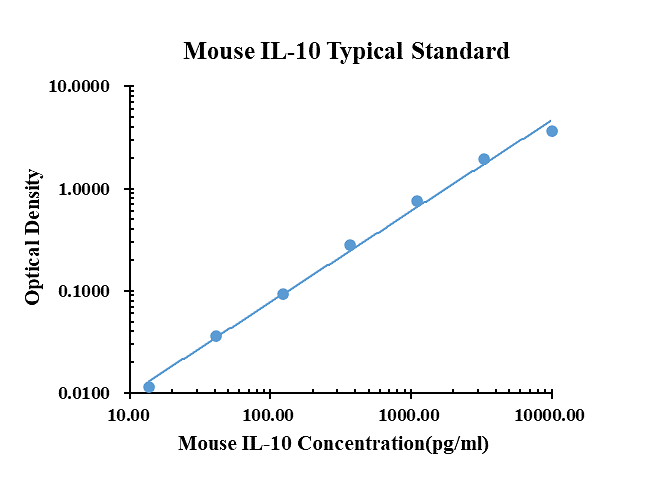Mouse IL-10 enzyme-linked immunoassay kit
| Specification | 96 Test |
|---|---|
| Sensitivity | 5.75 pg/ml (10 μl) |
| Standard Curve Range | 13.72~10000 pg/ml |
| Standard Curve Gradient | 7 Points/3 Folds |
| Number of Incubations | 2 |
| Detectable sample | Liquid phase sample of soluble substances. For example: serum, plasma, cell culture supernatant, tissue grinding liquid, etc. |
| Sample Volume | 10 μl |
| Type | Fully Ready-to-Use |
| Operation Duration | 120min |

| pg/ml | O.D. | Average | Corrected | |
|---|---|---|---|---|
| 0.00 | 0.0207 | 0.0209 | 0.0208 | |
| 13.72 | 0.0333 | 0.0311 | 0.0322 | 0.0114 |
| 41.15 | 0.0586 | 0.0553 | 0.0570 | 0.0362 |
| 123.46 | 0.1152 | 0.11215 | 0.1136 | 0.0928 |
| 370.37 | 0.3011 | 0.2984 | 0.2998 | 0.2790 |
| 1111.11 | 0.7795 | 0.7776 | 0.7786 | 0.7578 |
| 3333.33 | 1.9981 | 1.9036 | 1.9505 | 1.9297 |
| 10000.00 | 3.7131 | 3.7112 | 3.7120 | 3.6912 |
Precision
| Intra-assay Precision | Inter-assay Precision | |||||
| Sample Number | S1 | S2 | S3 | S1 | S2 | S3 |
| 22 | 22 | 22 | 6 | 6 | 6 | |
| Average(pg/ml) | 179.9 | 784.5 | 2838.4 | 218.4 | 918.7 | 2985.2 |
| Standard Deviation | 6.2 | 34.5 | 140.3 | 11.0 | 58.2 | 166.5 |
| Coefficient of Variation(%) | 3.5 | 4.4 | 4.9 | 5.0 | 6.4 | 6.6 |
Intra-assay Precision (Precision within an assay) Three samples of known concentration were tested twenty times on one plate to assess intra-assay precision.
Inter-assay Precision (Precision between assays) Three samples of known concentration were tested six times on one plate to assess intra-assay precision.
Spike Recovery
The spike recovery was evaluated by spiking 3 levels of mouse IL-10 into health mouse serum sample. The un-spiked serum was used as blank in this experiment.
The recovery ranged from 84% to 119% with an overall mean recovery of 103%.
Sample Values
| Sample Matrix | Sample Evaluated | Range (pg/ml) | Detectable (%) | Mean of Detectable (pg/ml) |
|---|---|---|---|---|
| Serum | 30 | 19.31-941.79 | 100 | 120.83 |
Serum/Plasma – Thirty samples from apparently healthy mice were evaluated for the presence of CXCL1/KC in this assay. No medical histories were available for the donors. n.d. = non-detectable. Samples measured below the sensitivity are considered to be non-detectable.
Product Data Sheet
Background: IL-10
Interleukin-10 (IL-10), also known as cytokine synthesis inhibitory factor (CSIF), is the charter member of the IL-10 alpha -helical cytokine family that also includes IL-19, IL-20, IL-22, IL-24, and IL-26/AK155. IL-10 is secreted by many activated hematopoietic cell types as well as hepatic stellate cells, keratinocytes, and placental cytotrophoblasts. Whereas human IL-10 is active on mouse cells, mouse IL-10 does not act on human cells. Mature mouse IL-10 shares 85% amino acid sequence identity with rat IL-10 and 70-77% with bovine, canine, equine, feline, human, ovine, and porcine IL-10. It contains two intrachain disulfide bridges and is expressed as a 36 kDa noncovalently-associated homodimer.
IL-10 mediates its biological activities through a heteromeric receptor complex composed of the type II cytokine receptor subunits IL-10 R alpha and IL-10 R beta. IL-10 R alpha is a 110 kDa transmembrane glycoprotein that is expressed on lymphocytes, NK cells, macrophages, monocytes, astrocytes, intestinal epithelial cells, cytotrophoblasts, and activated hepatic stellate cells, while the 75 kDa transmembrane IL-10 R beta is widely expressed. The IL-10 dimer binds to two IL 10 R alpha chains, triggering recruitment of two IL-10 R beta chains. IL-10 R beta does not bind IL-10 directly but is required for signal transduction. IL-10 R beta also associates with IL-20 R alpha, IL-22 R alpha 1, or IL-28 R alpha to form the receptor complexes for IL-22, IL-26, IL-28, and IL-29.
The involvement of IL-10 in immunoregulation includes both suppressive and stimulatory effects. It functions as an anti-inflammatory cytokine by inhibiting the expansion and activation of Th1 cells and Th17 cells and by promoting the development of M2 macrophages. Its expression by immunosuppressive regulatory T cells (Treg) and regulatory B cells is important for Treg proliferation. Within a tumor microenvironment, however, IL-10 inhibits the expansion of Treg as well as myeloid-derived suppressor cells. IL-10 induces the intratumoral accumulation and activation of CD8+ T cells. IL-10 exerts protective effects including limiting tissue damage in arthritic inflammation and promoting muscle regeneration after injury, but it also contributes to the persistence of viral infections. The levels of IL-10 are elevated in Sjogren's syndrome (saliva), primary CNS lymphoma (cerebrospinal fluid), and ovarian cancer (serum and ascites). Its levels are decreased in the serum in patients with recurrent heart attacks or during preeclampsia and also in the seminal fluid of infertile men.

